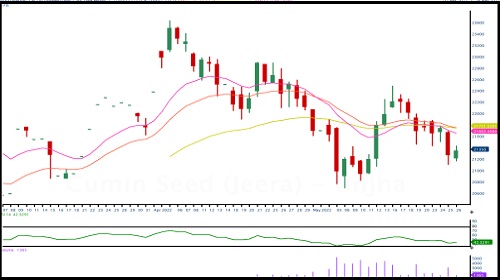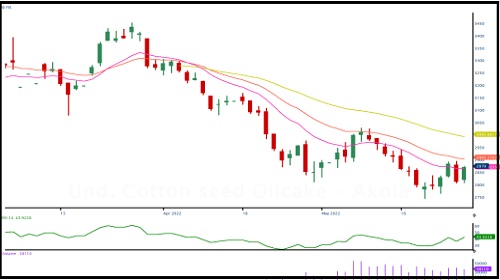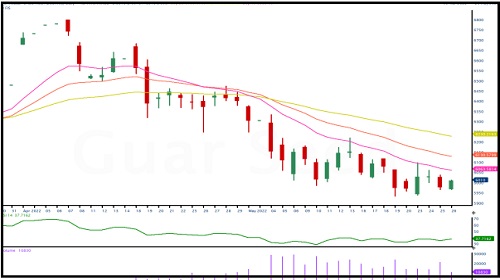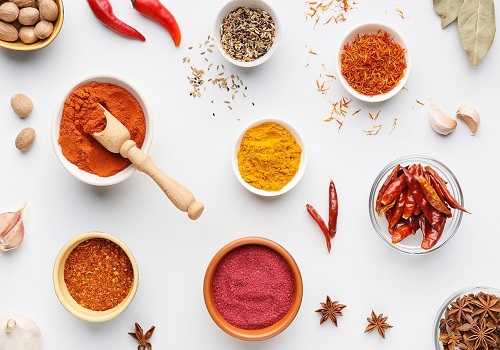Agri Picks Daily Technical Report 27 May 2022 - Geojit Financial Services

Follow us Now on Telegram ! Get daily 10 - 12 important updates on Business, Finance and Investment. Join our Telegram Channel
https://t.me/InvestmentGuruIndiacom
Download Telegram App before Joining the Channel
SPICES
• Spices on NCDEX traded steady to weak on Thursday. Short covering moves were seen in jeera futures after the previous day’s slump, while coriander and turmeric futures stretched losses. Subdued demand weighed on.
• The export of spices from India during Apr-Dec declined 7.5% on year to 1.2 mln tn, according to data from the Spices Board India. In terms of value, exports rose marginally to 230.7 bln rupees. Sluggish demand for chilli, jeera, turmeric, coriander and fenugreek weighed on exports.
• The exports of jeera during Apr-Dec declined 24.5% on year to 173,796 tn, from 230,120 tn a year ago.
• India exported 116,408 tn of turmeric in Apr-Dec, down 20.6% on year. Coriander exports were down 12.8% on year at 37,566 tn, data showed.
• Exports of small cardamom rose 68.3% on year to 7,337 tn. The huge rise was also seen in ginger exports, which rose 57.5% on year at 130,091 tn.
• Exports of chilli in Apr-Dec were down 7.6% on year at 435,725 tn, while mint product exports were at 21,386 tn, up 4.8% on year, according to the data.
• According to the second advance estimates by Gujarat state agriculture department, jeera production is seen declining to 236980 tons in 2021-22, down 41 per cent year on year. Area is seen at 289000 ha as against 473800 ha a year ago. Coriander production is seen declining as well to 211680 tons compared to 221240 tons in 2020-21.
• Government sees 2020-21 coriander output at 720000 tons compared to 701000 tons a year ago.
• Government sees 2020-21 turmeric output at 1.11 million tonnes compared to 1.15 million tons a year ago.
• Output of small cardamom is seen rising by 100% on year to 22520 tons according to the Spices Board.

COTTON
• The International Cotton Advisory Committee has raised its estimate or global cotton prices for 2021-22 (Aug-Jul) by 2 cents per pound from the previous month's projection to 115 cents per pound. The committee estimated global consumption at 26.2 mln tn in the 2021-22 season, the highest since 2018-19. Global consumption was at 25.7 mln tn in the previous season. The higher estimate is because of firm demand from Pakistan, Turkey, Bangladesh and Vietnam.Bangladesh and Vietnam have limited domestic production of cotton and thus require imports to support almost all their manufacturing needs. The committee estimated global ending stocks at 20.9 mln tn, slightly higher than 20.6 mln tn in the previous season. Global cotton export for the season is estimated at around 10.1 mln tn, as against 10.6 mln tn a year ago.Global production for the ongoing season is estimated higher at 26.4 mln tn, compared with 24.4 mln tn in the previous season. The rise has largely been attributed to higher production in Pakistan, Brazil and the US.In the US, cotton production is estimated at 3.8 mln tn, as against 3.2 mln tn a year ago. However, in India, cotton output is expected to fall to 5.8 mln tn, compared with 6.0 mln tn in the previous year.
• The UK-based Cotton Outlook has revised upward its estimate for global cotton production in 2021-22 (Aug-Jul) by 15,000 tn to 25.54 mln tn, the agency said in a report. The revision has been made as production in African Franc zone is expected to be slightly higher. Cotton production in India, is seen at 5.5 mln tn. The production in China is seen at 5.8 mln tn, while the US is likely to produce 3.8 mln tn. The agency has raised its estimate for global consumption in 2021-22 by 25,000 tn to 25.8 mln tn due to rise in demand from Indonesia.Global cottonending stocks for the ongoing 2021-22 season are estimated at 229,000 tn.
• The US Department of Agriculture has revised its estimate for cotton ending stock in India to 8.3 mln bales (1 US bale = 218 kg) for 2021-22 (Aug-Jul), from 8.0 mln bales projected a month ago.The increase in India's ending stock estimate is attributed to lower exports in the current season. The country's exports are projected at 5.2 mln bales, as against 5.5 mln bales a month ago.Persistently high prices in the domestic market have made India's cotton uncompetitive, weighing on exports of the commodity. According to trade sources, in the ongoing marketing year, around 3.5 mln bales (1 bale = 170 kg) of Indian cotton were exported till March, sharply lower than a year ago. In Oct-Mar of 2020-21, India had shipped 4.3 mln bales. The agency maintained its estimate for India's production and domestic consumption for 2021-22 at 26.5 mln bales and 26.0 mln bales, respectively. Further, the agency has scaled up its global production estimate to 120.2 mln bales from 119.9 mln bales a month ago. Global cotton consumption is seen lower at 124.1 mln bales in 2021-22, compared with 124.5 mln bales a month ago. Exports are estimated at 45.8 mln bales, as against 46.3 mln bales a month ago. The agency has raised its 2021-22 global ending stocks estimate to 83.4 mln bales from 82.6 mln bales estimated a month ago.
• The Cotton Association of India has cut its production estimate for the 2021-22 (Oct-Sep) marketing season to 33.5 mln bales (1 bale = 170 kg), from 34.3 mln bales projected a month ago. The cut in estimate can be attributed to some crop loss because of excess rain in November in the key producing states that impacted quality of crop. Of the total crop, 26.3 mln bales had arrived in markets across India till March. Estimate for exports in the ongoing marketing year has been maintained at 4.5 mln bales. India shipped around 3.5 mln bales of cotton till March.The association has also maintained its estimate for domestic cotton consumption at 34.0 mln bales, and imports at 1.5 mln bales.The ending stock for the 2021-22 season has been estimated at 4.0 mln bales, as against 4.8 mln bales projected a month ago.
• Cotton farmers in the US intend to plant the fibre over 12.2 mln acres in the 2022-23 (Aug-Jul) season, up by 9% from the previous year, the USDA said in its initial planting survey report for the season. The largest increase in sowing area is expected in Texas.A rise in acreage in the coming season is attributed to high cotton prices.
• Persistently high prices in the domestic market have made India's cotton uncompetitive, weighing on exports of the commodity in 2021-22 (Oct-Sep) season. In the ongoing marketing year, around 3.4 mln bales of cotton were exported till mid-March, a consignment of another 200,000-300,000 bales is expected to ship in coming days. Along with these consignments, by the end of March, exports may touch 3.6 mln bales so far this year, which is sharply lower than a year ago. In Oct-Mar of 2020-21, India had shipped 4.3 mln bales. Most consignments have been shipped to Bangladesh, followed by China, Indonesia and Vietnam. Of the total shipped quantity, Bangladesh bought around 2.5 mln bales so far this season. Domestic prices are at a record high level due to the tight supply situation in the market. A rise in domestic mill consumption and a decline in production due to untimely rains have led to a drop in ending stock estimates. Exports during Apr-Sep is seen declining further because of the elevated domestic prices as it makes overseas sales economically unviable, said Dharmendra Jain, director of Ahmedabad-based D.P. Cotton. Furthermore, exports to Bangladesh, has also slowed down because they have already booked their consignments. Now, they are only buying to meet immediate requirements in case of a delay in shipments from regions such as the US and Brazil. Industry experts say cotton exports this season might stand at 4.0-4.5 mln bales. In 2020-21 (OctSep), India exported 7.5-7.8 mln bales of cotton, with Bangladesh, China and Vietnam being the major buyers.
• The government has increased the maximum sale price of genetically modified Bollgard-II Bt cotton seed for 2022- 23 (Apr-Mar) by 43 rupees to 810 rupees for a 450-gm packet, according to a notification.
• The US Department of Agriculture has scaled down its estimate for cotton production in India to 26.5 mln bales (1 US bale = 218 kg) for 2021-22 (Aug-Jul), from 27.0 mln bales projected a month ago. The cut in India's output estimate is attributed to some crop loss because of excess rains in November in most key growing states. On the global front, the agency has scaled down its production estimate to 119.9 mln bales from 120.2 mln bales a month ago. The downward revision is mainly due to a likely smaller crop in India. The agency has lowered its 2021-22 global ending stocks estimate to 82.6 mln bales from 84.3 mln bales estimated a month ago. Global cotton consumption is seen a tad higher at 124.5 mln bales in 2021-22, from the previous month's estimate of 124.4 mln bales.
• The US Department of Agriculture's Foreign Agricultural Service has further scaled down its estimate for cotton output in India in 2021-22 (Aug-Jul) to 27.4 mln bales (1 US bale = 218 kg) from 27.7 mln bales projected in January. The reduction in cotton output estimate is attributed to crop damage due to rains in late September in key producing regions of Telangana. Meanwhile, the agency has raised its estimate for India's cotton consumption in 2021-22 to 26.5 mln bales from 26.0 mln bales estimated a month ago. Trade sources indicate that mill consumption is being supported by robust textile and apparel exports. Mills are reporting good margins and making investments in additional spinning capacity for the long-term. Exports during the season are maintained at 5.9 mln bales with Bangladesh, Vietnam, China, and Indonesia being the top export destinations. Bangladesh continues to be the major buyer of Indian cotton with almost 60% export market share. The estimate for imports into India in the 2021-22 crop year has been maintained at 1.0 mln bales. The closing stock of cotton for the country has been pegged at 9.7 mln bales, compared with 10.8 mln bales estimated the previous month.
• The new season for cotton which started on Oct 1, is expected to be good for farmers as the market price of the fibre is currently more than the minimum support price, due to firm demand and a rise in global prices.
• Sowing of cotton across the country has ended and farmers have sown the crop across 12 mln ha in the 2021-22 (JulJun) kharif season, down 6% from a year ago, data from the farm ministry.
• India's cotton output in the 2021-22 (Oct-Sep) marketing year is seen at 36.2 mln bales (1 bale = 170 kg), as per the median of estimates of 13 prominent players in the cotton value chain polled by Informist. • In the ongoing 2021-22 (Jul-Jun) season, cotton acreage across the country was 11.9 mln ha as on Thursday, down

OTHERS
• The government will purchase an additional 136,225 tn chana in Gujarat, a government official said. "The Centre on May 15 has given the nod to an additional quantity on the request of the Gujarat government as the state's 90-day procurement window is still open for 10-12 days," the official said. The government, through its nodal agency National Agricultural Cooperative Marketing Federation of India, had started chana procurement in Gujarat on Mar 1 for the initially sanctioned quantity of around 400,000 tn. As many as 255,099 farmers across 117 centres of Gujarat have so far sold 502,164 tn chana to NAFED, the official said. The government has wrapped up the procurement drive under the price support scheme in states such as Karnataka, Telangana and Haryana, the official said. NAFED bought a total of 133,628 tn from 100,472 farmers across 282 centres of Karnataka, Telangana and Haryana. The government agency has so far purchased 1.8 mln tn chana from 881,071 farmers across 2,981 centres in all key producing states. This is almost 19% of the estimated production in the country for the 2021-22 (Jul-Jun) crop year. NAFED is procuring chana at the minimum support price of 5,230 rupees per 100 kg for the 2022-23 rabi marketing year to arrest the fall in price, and aims to buy a total of 3.1 mln tn until July.
• Recent report from U.S. Department of Agriculture (USDA) reveals that Chickpea area is likely to fall by 18 percent to 303,600 acres as growers are not less interest to sow Chickpea in a big way. However, small Chickpea area is estimated to increase from 2021 by 5 percent to 62,100 acres. Area under the large Chickpea in 2022 is estimated to be at 241,500 acres down by 22 percent from previous year.
• The Securities and Exchange Board of India has asked the National Commodity and Derivatives Exchange to not launch any new chana contracts on its platform till further notice, the market regulator said in a release on August 16, 2021.
• India’s guar export in Oct’21-Feb’22 is up by 28% to 1,25,921 MT as compared to 98,379 MT previous year same period. Russia bought 3,579 tonne (17.44%) of the total guar gum exports in Feb’22 as compared to 3,519 tonne (16.47%) previous months
• India’s guar gum exports decreased in the month of February 2022 by 4% to 20,518 tonne compared to 21,373 tonne during previous month at an average FoB of US $2,326 per tonne as compared to US $2,171 per tonne previous month. However, the gum shipments were up by 14.53% in Feb’2022 compared to the same period last year. Of the total exported quantity, around 6,406 tonne (31.22%) bought by US, Russia bought 3,579 tonne (17.44%), Germany bought 2,356 tonne(11.48%), China bought 1,230 tonne (5.99%), and Canada bought 897 tonne(4.37%). Additionally, India’s guar split exports increased in the month of Feb’2022 by 35.60% to 5,485 tonne compared to 4,045 tonne previous month at an average FoB of US $ 1,815 per tonne compared to US $ 1,780 per tonne previous month. However, the guar split shipments gone up by 85.03 % in Feb’22 compared to the same period last year. Of the total exported quantity, around 3,460 tonne (72.20%) bought by China, US bought 760 tonne (13.86%),Mexico bought 405 tonne(7.38%) and Switzerland bought (6.56%).
• Global production of natural rubber rose 13.6% on year to 941,000 tn in April, and demand is estimated to have increased 0.3% to 1.21 mln tn, the Association of Natural Rubber Producing Countries said in a monthly report. Despite market fundamentals remaining favorable, the industry was severely affected by external global events, the association said. The World Bank has revised downwards its projection for global economic growth to 3.2% for 2022 from 4.1%, due to Russia's invasion of Ukraine and lockdowns related to COVID-19 in China as they pose uncertainty and may slow down prospects for global economic recovery.

OILSEED
• The government has allowed import of 2 mln tn of crude soyoil and crude sunflower oil per year each at nil duty under the tariff rate quota, the finance ministry said in a release. Imports made against the tariff rate quota will be effective from Wednesday till Mar 31, 2024.
• The US Department of Agriculture in its May report has projected global oilseed output for 2022-23 (May-Apr) to rise 8.4% to 647.2 mln tn from 596.9 mln tn recorded last year. The agency attributed the jump to an estimated record soybean harvest in Brazil and Argentina. The agency has projected global soybean output to rise by 45.3 mln tn to 394.7 mln tn. Brazil's soybean crop is estimated at a record 149 mln tn, while Argentina's crop is seen 9 mln tn higher at 51 mln tn. The agency has scaled up its estimate for global ending stocks for 2022-23 to 99.6 mln tn, up 14.4 mln tn year-on-year, with most of the increase in Brazil, Argentina, and the US. Estimate for global soyoil production for 2021-22 has also been revised upwards to 61.4 mln tn from 59.1 mln tn recorded the previous year. Moreover, the estimate for global soyoil exports in 2022-23 has been revised marginally higher to 12.8 mln tn from 12.3 mln tn. The department projected global soymeal output for 2022-23 at 256.5 mln tn, up from 246.1 mln tn on year. The estimate for global exports of soymeal in 2022-23 is higher at 69.8 mln tn, compared with 67.7 mln tn pegged the previous year.
• India's vegetable oil imports in April fell nearly 13% on year to 911,846 tn, The Solvent Extractors' Association of India. The fall in imports is primarily due to supply constraints because of the Russia-Ukraine geopolitical conflict, coupled with Indonesia's ban on the export of palm oil, among other cooking oils, in effect from Apr 28. During Nov-Apr, imports of vegetable oil stood at 6.7 mln tn, as against 6.4 mln tn a year ago. Edible oil imports were at 900,085 mln tn in April, against 1.03 mln tn a year ago. For Nov-Apr, these imports stood at 6.5 mln tn, as against 6.3 mln tn in the year-ago period. In April, 414,829 tn of crude palm oil was imported, as against 689,731 tn during the same month last year. As on May 1, 416,000 tn of edible oil was at ports, against 491,000 tn a year ago, while 1.8 mln tn was in the pipeline, against 1.3 mln tn during the same period last year.
• India's oilmeal exports fell 25% on year to 242,043 tn in March, according to data released by The Solvent Extractors' Association of India For 2021-22 (Apr-Mar), exports of oilmeal were down 36% on year at 2.4 mln tn.The fall in oilmeal exports was mainly attributed to decline in export of soybean meal. Soymeal exports plunged to 372,740 tn during 2021-22 from 1.6 mln tn in the year-ago period. "Crushing of soybean is low as farmers are holding stock in anticipation of higher prices as seen by them in last year,". Lower crushing of soybean also led to higher imports of crude soybean oil. Mustard meal exports in 2021-22 fell 22.2% on year to 866,407 tn, and exports of castor meal were down 8.9% at 382,424 tn.
• Soymeal exports in March slumped 81.9% on year to 50,000 tn, the Soybean Processors Association of India said in a release. During Oct-Mar, soymeal exports fell sharply to 472,000 tn compared with 1.6 mln tn for the same period a year ago. In March, soymeal production fell to 519,000 tn from 678,000 tn a year ago, while during Oct-Mar, output was at 3.2 mln tn, lower than nearly 5.0 mln tn during the same period a year ago. However, during Oct-Mar, arrivals declined to 6.1 mln tn from 7.5 mln tn during the same period last year. By the end of March, mills, traders, and farmers were left with around 6.75 mln tn of soybean stock.
• The Centre has extended stockholding limits on edible oils and oilseeds by six months till Dec 31 in a bid to check hoarding and check prices of the commodities in domestic markets, a government release said. In February, the Centre had imposed stockholding limits till Jun 30.
• India's mustard seed production in the crop year 2021-22 (Jul-Jun) is seen 29% higher at an all-time high of 10.95 mln tn, the Central Organisation for Oil Industry & Trade said in a release. In the previous year, mustard seed production was at 8.5 mln tn, according to the release. The area under has been pegged at 8.7 mln ha, and the average yield is estimated at 1.3 tn per ha.
• With the shortage of edible oil supply from imports due to the crisis in Ukraine, the Soybean Processors Association of India has recommended measures to augment the supply and cool down prices. The agency estimates a shortfall of edible oil supply from imports due to the war of approximately 200,000 tn a month of sunflower oil, it said in a note.
• The National Commodity & Derivatives Exchange will launch future contracts in refined castor oil on Mar 21, the bourse said in a circular. According to the contract specification the commodity will have trading unit of 2 tn, with the maximum order size of 200 tn. The contract will be settled in cash. The open interest threshold level to attract concentration margin in the commodity will be 17,900 tn.
• The government cut agriculture cess on crude palm oil and extended the lower customs duty on edible oils by six months till Sep 30 to cool domestic prices. The government cut Agriculture Infrastructure and Development Cess on crude palm oil to 5.0% from 7.5%, a finance ministry notification said. The Centre had in October slashed import duty on key edible oils till Mar 31. This has now been extended till Sep 30, the notification said.
• Farmers have sown mustard across 9.16 mln ha in the country, up 25.3% on year, in the ongoing 2021-22 (Jul-Jun) rabi season as of Friday, according to the farm ministry's data. The government fixed the minimum support price of the crop at 5,050 rupees per 100 kg for the 2022-23 (Apr-Mar) marketing season, as against 4,650 rupees in the previous year.
• The Solvent Extractors' Association has urged the Centre and the Securities and Exchange Board of India to resume futures trade in mustard seed on the National Commodity and Derivatives Exchange.
• The Solvent Extractors' Association has urged the government to exempt soyoil from genetically-modified labelling requirement as it may lead to a rise in prices, it said in a letter. Last year, according to reports, the Centre had asked states to enforce separate labelling for genetically-modified soyoil to help consumers make informed decision.
• The Centre has included soymeal under the Essential Commodities Act with immediate effect till Jun 30 to regulate production, stocking, and distribution of the commodity.
• The government has reduced the basic import duty on refined, bleached, and deodorised palm oil, to cool domestic prices, the finance ministry said in a notification. The new duty rates will be in place till Mar 31, the ministry said. The effective basic import duty on refined, bleached, and deodorised palm oil has been reduced to 12.5% from 17.5% earlier. With the new duty cut, the duty difference between crude palm oil, which is a raw material, and refined, bleached, and deodorised palm oil, which is the finished product, has reduced to 5.5% from 11.0% earlier.
• The Securities and Exchange Board of India asked exchanges not to launch new contracts of some farm commodities, including those of soybean and its derivatives, and crude palm oil. The restrictions come into effect immediately and shall be applicable for one year.
• The Central Organisation for Oil Industry and Trade has estimated India's mustard output in the 2021-22 (Jul-Jun) rabi season at 10-11 mln tn because of increase in acreage, it said in a release. In 2020-21 the country produced around 8.5 mln tn of mustard, which is a crucial oilseed sown in the rabi season during Sep-Oct and harvested from February.
• India's 2020-21 (Jul-Jun) mustard output is seen rising 22.6% on year to 8.95 mln tn, according to a joint survey by the Central Organisation for Oil Industry and Trade and the Mustard Oil Producers' Association.
• The government reduced the effective import duty on CRUDE PALM OIL to 8.25% from 24.75%, and the effective import duty on REFINED SOYOIL to 19.25% from 35.75%
• India's soybean acreage in the 2021-22 (Jul-Jun) kharif season remained unchanged at 12.2 mln ha, agri ministry.
• India's castor seed production estimate for 2021-22 (Jul-Jun) has been revised down to 1.69 mln tn from 1.75 mln tn estimated in April, according to a survey conducted by the Solvent Extractors' Association through a private agency.
• Malaysia's crude palm oil output rose 24.1% on month to over 1.4 mln tn in March, data from the Malaysian Palm Oil Board. Export of palm oil in March rose 14.1% on month to 1.27 mln tn, while outbound shipments of biodiesel fell sharply by 64.6% on month to 15,853 tn, the data. The total palm oil stocks in the country fell nearly 3% on month to around 1.47 mln tn as of Mar 31.
• Malaysia's palm oil exports during the April 1-25 period are estimated to have fallen 13% on month to 897,683 metric tons, cargo surveyor SGS (Malaysia) Bhd.
To Read Complete Report & Disclaimer Click Here
For More Geojit Financial Services Ltd Disclaimer https://www.geojit.com/disclaimer
SEBI Registration Number: INH200000345
Views express by all participants are for information & academic purpose only. Kindly read disclaimer before referring below views. Click Here For Disclaimer























